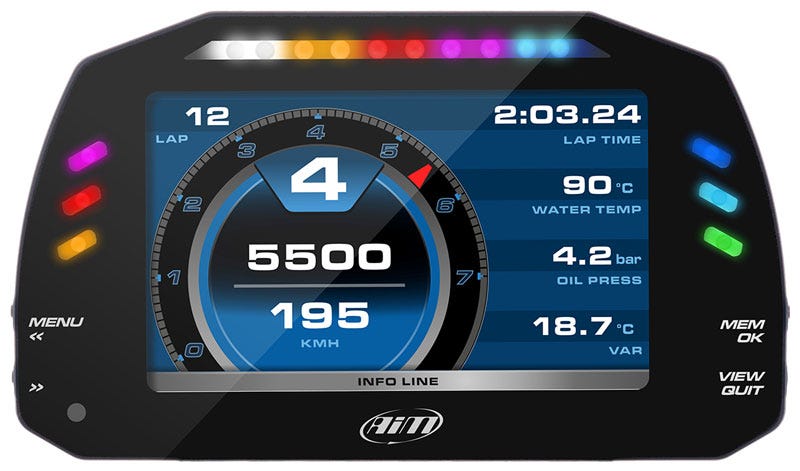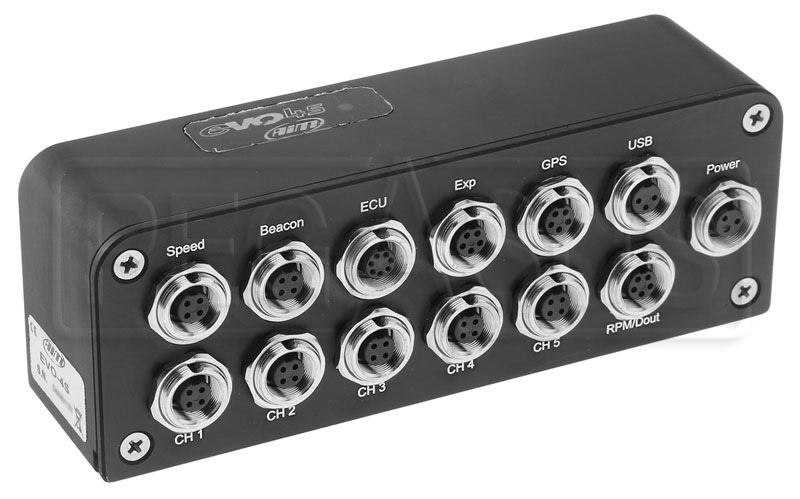Intro to Data Acquisition - Hardware
When I first started riding track, I used a couple of different SmartPhone apps for lap times with an external GPS unit. I was aware of real lap timers/data loggers but couldn't get my head around the cost. Gratefully I came to my senses not too far into working on my riding that I bit the bullet and started using proper equipment. The call for quality equipment was for ease of use, reliability, and for actually reviewing true data, not just lap times. I went with the AiM line of equipment because of the amount of community and brand support for the products. AiM equipment is used by professional race teams and is huge not just in high-end motorcycle circles, but also automotive and karting, which, by the numbers, are far larger components of high-performance driving/riding than motorcycles.
With that out of the way, AiMs product line is fairly comprehensive albeit sometimes confusing. I'll try to clear some of it up with answers to the more common questions I get in selecting equipment.
AiM Product Selection
You can get a lot out of just the entry-level AiM Solo 2. Most immediately it will serve as a GPS-based lap timer and comes pre-loaded with hundreds of US-based tracks. You can literally charge it, mount it to your vehicle, and go. As you work on your skills though, the real power is when you install the [free] AiM Race Studio software (Windows operating system required, no mobile apps available as of this writing). With just the Solo 2 (base model) you can review your speeds at any point on the track as well as looking for slow points, acceleration and deceleration rates, lateral and longitudinal G force, review split times reports for best rolling lap times, or optimal lap times and easily compare with a session or with other drivers/riders.
The next step up is the Solo 2 DL (data logger), which looks nearly the same as the non-DL version but it has two ports on the leading edge. One is for connecting to their SmartyCam HD camera system and the other is used for charging or connecting to the vehicle’s ECU in order to collect other data (more to come on that). On one bike, I used this with the optional RPM harness that powered the Solo as well as had a lead that connected to the coil on the bike which in turn gave me engine RPM which I configured to display on the Solo 2 DL since the OEM tachometer was exceedingly difficult to see.
AiM also offers complete dash/data loggers to replace or supplement your vehicle’s existing dash. You need to check compatibility with your vehicle first though. These have analog inputs for additional sensors (brake pressure, suspension potentiometers, etc.).
There are also a couple of dedicated data loggers: the EVO4s and the EVO5. These are basically black boxes that require connection to the vehicle’s ECU but can be supplemented with dedicated dashes, cameras, and additional sensors.
If you’re just getting started and if your vehicle isn’t listed in the compatibility list, a Solo 2 is a great place to start. One of the nice things about AiM hardware is the exceptional resale values so upgrading isn’t terribly painful. If you have multiple vehicles (car, bike, motocross, kart, etc.), you can also move your Solo from one vehicle to another. Probably the easiest way to do that is with spare mounting brackets that can be affixed to each vehicle, then you just need to move the Solo from one to the next.
I advise periodically updating your AiM products from within the Race Studio software. This includes updating track maps. Both are updated fairly regularly.
If you’re looking to do a deeper dive into data, such as throttle usage, gear selection, shift points, etc., you may want to look at a Solo 2 DL or one of the data logger dashes (MXM, MXS) or the modular data loggers (EVO4s, EVO5).
ECU Compatibility List (official): https://www.aim-sportline.com/en/documentation-stock-ecu-connections.htm
A lot of manufacturers use the same ECU and/or data stream across models so even if your bike isn’t listed it *may* work. My 2020 Triumph isn’t listed but it works using the 2013 ECU profile. Your mileage may vary.
Using the ECU connection will usually provide you with at least throttle position, gear position, wheel speed, and RPM. Some bikes have more comprehensive data.
*Most* stock bikes DO NOT have brake pressure in the ECU stream, check the above compatibility list. It’s mostly expensive European literbikes that do (the RS660 does NOT, although it has a lot of other interesting data available in the ECU data stream).
AiM Solo 2 DL is required to pull off the ECU stream, that’s the minimum product in the AiM catalog however no analog data can be obtained. In other words, if the bike’s ECU stream does not have brake pressure or suspension data (see above list), you will need higher spec AiM equipment (EVO4s, EVO5, MXm, MXs).
If your bike does have brake pressure in the ECU stream but you bypass the ABS, you will lose the brake pressure data.
If you want to capture brake pressure data and it’s not in your ECU data stream or if you’ve bypassed ABS, you will need a data logger that has analog inputs. Those products will be the MXm & MXs dashes or the EVO4s or EVO5 loggers. The necessary analog feed will be a brake pressure sensor, a T fitting or inline adapter, and the appropriate cable to connect to the dash or logger. A second sensor will be necessary if you wish to capture rear brake data.
The EVO loggers do not have a display natively however you can add the GS dash which is similar in size to the Solo 2.
If you wish to replace your dash with an AiM MXM or MXS dash-logger, AiM notes that some bikes will require the stock dash or the bike may not work unless you do a complete ECU and harness conversion. These are detailed in the application list.
N.B. Actual brake pressure isn’t completely necessary to review effective braking force. Since all the Solos, dashes, and data loggers have internal gyros, you can use the longitudinal G-force measure. For reference, not counting aerodynamic forces which come into play at higher speeds, the rear wheel of a motorcycle will begin to lift at approximately -1.0g. Decelerating from 150mph, due to wind resistance, it is possible to see close to -1.5g in deceleration.
For those planning on flashing their ECUs, check with the provider to make sure that you will still be able to capture data on the ECU data stream and potentially obtaining more data.
If your bike isn’t on the list, you can check with the AiM support or the AiM Facebook User Group to ask if anyone has experience with getting data on your bike. Also, bike-specific forums may be a good resource. At the very least, you can easily capture RPM data with the AiM ignition coil cable. You can also do calculated gear that way though the latter will not be as accurate as an ECU feed.
What I Use
I initially started out with a Solo 2 DL and a SmartyCam HD GP version. This worked fine although I had a couple of issues: 1) the mounting location for my Solo 2 DL had it in the nose of the bike, to the left of the fairing stay. As a result, in long left-hand corners, I'd see glitches in the speed, likely due to the fact that the Solo lost satellite signal for a couple of consecutive seconds. Additionally, my riding coach was wanting to see brake pressure data. After several inquiries to Triumph, AiM, and others, it seemed that there would be no way for me to capture brake pressure data in the data stream from the ECU.
At the end of 2020, I upgraded to the EVO4s, retained the same camera, added a data expansion hub, the AiM 2000psi brake pressure sensor connected to the front brake line, a GS dash, and the shift light. This model also has an external GPS receiver which I mounted on the tail section with a clear view of the sky. At the end of 2021, I'm adding suspension potentiometers. If I could have, I would have gone with the MXS v1.2 dash (TFT) instead of the EVO4s & GS dash but on my bike, with the stock ECU and harness, I have to retain the stock dash. It's not a bad dash, but the MXS is soooo nice and configurable! I still have the Solo 2 DL which I used with my race bike in early 2021 (KTM RC 390) but that bike didn't have an ECU profile so I added the RPM sensor harness and added a new display page to the Solo 2 which included the engine RPM which worked out to be far more visible than the stock tachometer. Now the Solo 2 sees occasional duty on my street bike when I take it to the track and on my mini-moto at kart days.







